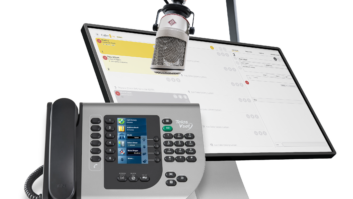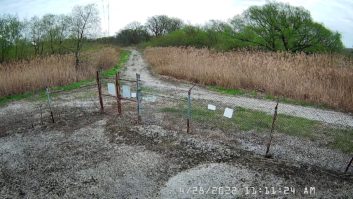If you maintain an older tower, lit with traditional red lighting, you might want to investigate the Dialight 860 series of red LED obstruction lights and beacons. In addition to a service life up to 10 times that of an incandescent bulb, the energy consumption is dramatic: 12.5 watts vs. 116 watts for the incandescent.
The cost of electricity keeps rising, so any legitimate way to save on operating expense should be considered. An added plus: these folks are open to SBE shapter presentations. I saw their demonstration in New York a couple of months back. The program is informative, and those lights are bright!
You can get the details at www.dialight.com or contact the company at (723) 223-9400 to get data sheets. Show your manager that you are concerned about his bottom line. Here’s an excellent way to invest a little money to save a lot of money.
. . .
(click thumbnail)Fig. 1 How’s your grasp of transmitter history?
So how’s your grasp of transmitter manufacturer history?
My friend and associate Stephen Schott handles radio sales for Harris in Texas and Oklahoma. He sent me the sobering word puzzle shown in Fig. 1 – sobering, because there sure have been a lot of radio transmitter companies over the years.
Use the list and see how many you can find. The answer key will appear next issue.
Seasoned engineers may be able to find the companies without the list!

. . .
Digital Innovations has a solution for those scratched CDs that you’re ready to toss.
The SkipDoctor looks like an oversized manual can opener. You snap the offending CD into the jaws, apply a resurfacing fluid and turn the crank. The disk rotates beneath a resurfacing wheel. The scratch is removed as the disk is resurfaced.
For visible flaws, there’s a “reversible” switch, so you can concentrate the resurfacing on a specific part of the disk.
After buffing, the resurfacing pattern created by the SkipDoctor is virtually invisible when viewed straight on. The resurfacing pattern is visible when viewed at an angle, but the effect is harmless. The CD player laser “sees” the disk straight on, so the resurfacing pattern is of no consequence. Label-side damage cannot be repaired by this device; however, the same CD can be repaired multiple times.
Digital Innovations has a useful guide for caring for CDs and a copy is available from the company’s Web site at www.digitalinnovations.com or by calling the company at (888) SMART-58.
Thanks to Wendell Hall at WJFK(FM), one of the Infinity stations in Washington, for sharing the SkipDoctor with Workbench readers.
. . .
(click thumbnail)Fig. 2 ‘Hey ma, how come there’s a tree growing in the air?’
Fig. 2 is from our collection of “you gotta see this” pictures. Yes, those are tower guy wires, and it’s no trick photography; there was a tree growing through the guy. The new owners of this site had their work cut out for them, playing catch-up to years of abuse and neglect by the previous owner. If your GM ever questions why you visit the transmitter site, put a copy of this picture on his desk.
It’s true that trees this size don’t grow overnight, but it’s amazing how quickly shrubs, grass and trees can sprout up in places that can make your life difficult. So visit that transmitter site. Walk the property. Inspect, inspect, inspect, and correct the problems when they are small.

. . .
How is your supply of spares at the transmitter site?
Have you checked your fuse supply? Don’t forget the large fuses in the transmitter and air-conditioning disconnects.
Mike Patton, a contract and projects engineer in Louisiana, also reminds engineers to check your stock of replacement light bulbs, filters and even batteries for things like a calculator or DVM, and the “memory” battery for your solid-state transmitter.
Mike adds some inexpensive purchases: electrical tape, several pieces of heat shrink and a hardware assortment, for starters.
For FMs, a spare tank of nitrogen is inexpensive insurance. So is a spare muffin fan. Even if the muffin fan isn’t a drop-in for the original, it usually can be rigged to limp by until the replacement arrives. Grainger is a good source of fans and blower motors large and small.
With the cold weather underway, it pays to think ahead. It’s easy to get stranded at remote transmitter sites. A can of sterno, matches and a couple cans of hearty soup, stew or baked beans are wise additions. Add a gallon jug of water to round out your “meal.”
An army surplus store offers great finds. When I was contracting, we picked up collapsible cots for under $10 each and placed them at the more remote transmitter sites of our clients. The surplus store has inexpensive blankets, and those “space” blankets that look like big pieces of aluminum foil and conserve your heat. These blankets are small and fit easily on a shelf until needed.
If you stock your transmitter site with a traditional blanket, make sure you store it inside a sealed plastic bag. Otherwise, critters may take to nesting in the warm wool.
Of course, you can’t go wrong with a flashlight with fresh batteries.
A box of trash bags and a garbage can are useful additions. If there’s no workbench at the transmitter site, consider adding a folding table and at least two chairs. You can pick these up at second-hand stores like Goodwill and Salvation Army. If you can find the padded type of folding chair, you’ll appreciate the added comfort at 2 a.m.
Submissions for this column are encouraged, and qualify for SBE recertification credit. Fax your submission to (703) 323-8044, or send e-mail to [email protected]












